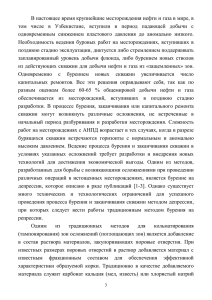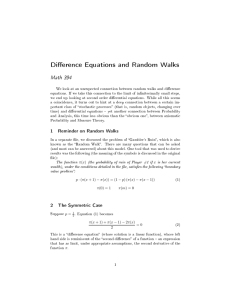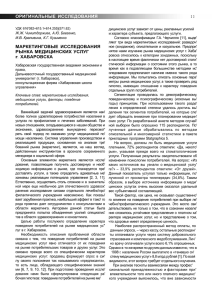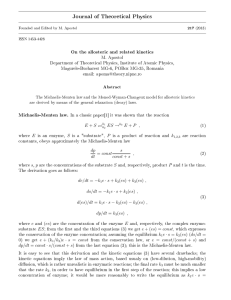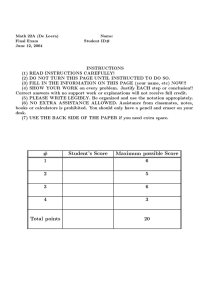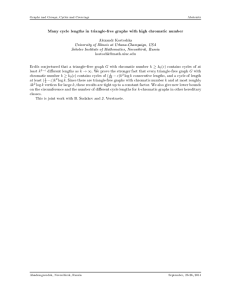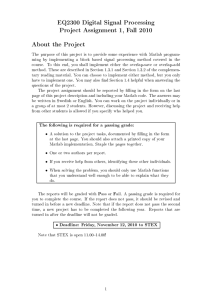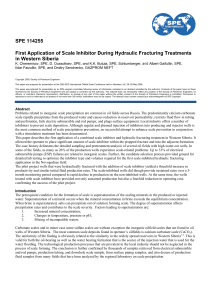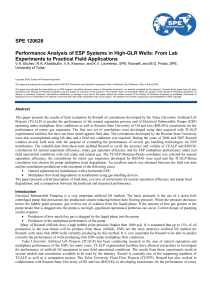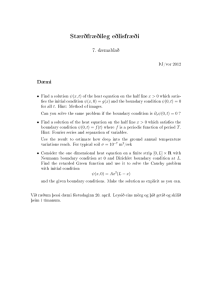л п р × с жж ып ж э срв
реклама
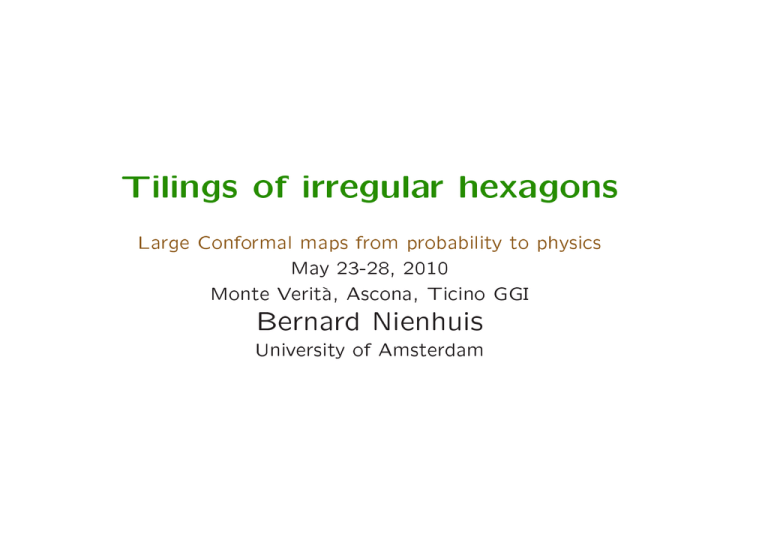
Tilings of irregular hexagons Large Conformal maps from probability to physis May 23-28, 2010 Monte Verita, Asona, Tiino GGI Bernard Nienhuis University of Amsterdam Outline The model Why do physiists look at this model Why do mathematiian look at this model Bethe Ansatz Yield transition Conformal behavior 1 The model: hexagonal net 2 The hexagons an grow at the expense of their neighbors, with the onstraint that all sides are non-negative. 3 The model Why do physiists look at this model Why do mathematiian look at this model Bethe Ansatz Yield transition Conformal behavior 4 An monolayer of atoms adsorbed on a rystal surfae, suh that the latties are inommensurable. 5 An monolayer of atoms adsorbed on a rystal surfae, suh that the latties are inommensurable. 6 An monolayer of atoms adsorbed on a rystal surfae, suh that the latties are inommensurable. 7 An monolayer of atoms adsorbed on a rystal surfae, suh that the latties are inommensurable. 8 An monolayer of atoms adsorbed on a rystal surfae, suh that the latties are inommensurable. Hexagonal network of domain walls (Villain 1980) 9 This random paking of disks is equivalent to a tiling of squares and triangles. (given the appropriate size ratio, and maximal paking density) 10 When there are far more triangles than squares, the tiling behaves like a hexagonal net. (Oxborrow, Henley 1993) 11 In the trimer model, analogous to the dimer model, every site of the triangular lattie part of one triangular trimer. (Verberkmoes, BN 1999) Equivalently the hexagonal lattie is tiled with 'triominos'. 12 When the trimers predominantly point the same way, the trimers with minority orientation are sorted out along a hexagonal net. The dierent olors represent dierent sublatties. (The Y vertex omes in two hiralities) 13 Fores in disk pakings Imagine the disks to be perfetly hard. Eah disk is held in plae by the ontat fores from its six neighbors. For eah disk two balane equations, and three fores to solve them. (Ostoji, BN 2005)[2m℄ 14 F1 F1 F2 F3 F6 F5 F4 F2 F6 F3 F5 F4 F2 F1 F6 F3 F5 F4 Represent the fores by linesegments perpendiular to the diretion of the fore with length proportional to the strength. Then these linesegments form a losed hexagon.(Maxwell) Plaing these in one gure gives a hexagonal net 15 The model Why do physiists look at this model Why do mathematiian look at this model Bethe Ansatz Yield transition Conformal behavior 16 Sums of hermitian matries Let be a weakly dereasing sequene of real numbers, and H be set of hermitian matries with eigenvalues . For what , and does M +M +M =0 (1) have solutions in H , H and H , respetively? In other words: if we know (only) the spetrum of two hermitian matries, what does that tell us of the spetrum of their sum? Horn (1962) onjetured that a set of inequalities (together with the obvious ondition on the trae) are suÆient onditions for (1) to have a solution. In 2000 Knutson and Tao proved this to be orret, and formulated it in terms of the hexagonal net: 17 Knutson & Tao: The matries with spetra , and an add to zero if the spetra an be onneted with a hexagonal net. Even stronger: with uniform measure on the matries and on the hexagonal net, the partition funtion of the hexagonal net measures the relative probability that is the spetrum of M + M . 18 For integer sequenes (or equivalent Young tableaux): Let V be a representation of U(n). Then the number of times that V ours in V V is given by the number of (integer) hexagonal nets that onnet , and . These Littlewood-Rihardson oeÆients are also naturally represented as tilings with squares and triangles. (Zinn-Justin, 2009) 19 The model Why do physiists look at this model Why do mathematiian look at this model Bethe Ansatz Yield transition Conformal behavior 20 Some alulational tools Transfer matrix: add one row of disks Use the Bethe Ansatz to diagonalize the transfer matrix: The positions of the diagonal lines proeed with plane waves as weight funtion, between ollisions (i.e. events that two lines oinide). On ollision the wave numbers may be interhanged. This suggests that the eigenstates of the transfer matrix an be written as a linear ombination of produts of plane waves: 0 1 X X (x1; x2; : : : ; y1; y2; : : :) = A exp ix p ( ) + iy q ( )A N ; ; j =1 j j j j 21 This turns out to \work" (i.e. solve the eigenvalue equation). This implies that multiple ollisions an be written as a sequene of binary ollisions. The eigenvalue equation T = results in the following onsisteny onditions (B.A.eqns) on the wave numbers: Y Y u (u v e ) = u (u v e ) = v v =1 =1 where u = exp(ip ) and v = exp( iq ), and e is the weight of one unit vertial line. In these equations we want to take two (independent) limits: (i) The disrete hexagonal to the ontinuum, and (ii) the number N of hexagons in a row to 1. The seond limit turns the (logarithm of the) produts into integrals. N j k k j k F k j N k k j j j F 22 In the limit we get integral equations: Z dy g (y ) f (z ) = Fu + 2 i (z + y ) Z dz f (z) g (y ) = Fv + 2i (y z) with the restrition that Z g(y) dy Z f (z) dz = = 1 2 i 2 i The entropy per added hexagon is then given by Z dy Z dz log( y z ) S= 2 i 2 i The funtion f is analyti exept in a ut ! , and g is analyti exept in a ut + ! + . From the integral equations it follows that for on the ut in f : f ( + ") f ( ") = g ( + ) 23 In two limits we an make progress with these equations: (i) In the limit that the uts in f and g are very far apart. (ii) In the speial ase that the end points of the uts in f (z) and in g(z + ) oinide, the monodromy struture simplies. 1.5 1.5 + =2 =2 + =2 = =2 1 1 0.5 0.5 0 0 -0.5 -0.5 -1 -1 -1.5 -1.5 + =2 -1 -0.5 0 0.5 = 2 1 1.5 -1.5 -1.5 + =2 = -1 -0.5 0 = 0.5 2 1 24 1.5 The oinidene of the endpoints of the uts (one omplex equation) requires the symmetry ondition Fu = Fv: the asending lines and desending lines are equal on average, and a speial tuning of the parameter , whih ontrols Fw the length of the vertial lines. This ase was solved as follows (Kalugin (1994)): Passing through both uts 6 times leaves both f and g invariant This immediately suggests an unfoliation of the Riemann sheets, to nd new variables in whih the solution is analyti. On an assume the o-inidene to happen, leaving the speial value of where this happens, and the position of the endpoint as unknowns. The known properties of the funtions leaves enough equations to solve for these unknowns. The result for the partition sum per hexagon is e = 6F exp( 3=2) with F = Fu = Fv = Fw the mean side length in all three diretions. S 25 The model Why do physiists look at this model Why do mathematiian look at this model Bethe Ansatz Yield transition Conformal behavior 26 Questions: Is the distribution sale invariant ... onformally invariant partition funtion orrelation funtions nature of the yield transition: 27 In the ontinuous ase only the ratios of Fu, Fv and Fw matter. There are two free parameters. In the enter we have an exat expression for the partition funtion. We know that it vanishes at the boundary of the triangle, (where one of the F 's vanishes). + 2dyi (z +g(y) y) Z dz f (z) g (y ) = Fv + 2i (y z) ( )= f z Fu Z When 1 the denominator of the integrand is always big, and an be expanded in powers of 1=. In this limit Fw is very small. 28 This is a tedious proess, as the funti ons f and g as well as the integration boundaries and have to be alulated order by order. But it leads to a onsistent series For ompat notation I introdue: a = Fu 1 1 and b = Fv 1 1. In that notation: 1(a2 + b2) 1 (a3 + b3) + 1 (a4 + b4) + 1a2b2+ S = log( ) 6 2 20 6 5 (a5+b5)+ 2 a2b2(a+b)+ 9 a3b3 1 (a6+b6) 1 a2b2(a2+b2) 12 3 4 2 42 6 7 (a7 + b7) 17 a2b2(a3 + b3) 23 a3b3(a + b) + 20 12 30 so far up to 10 orders. Conversion from S(Fu; Fv; ) to S(Fu; Fv; Fw) is still needed, but does not seem to improve the esthetis. What is surprising is that the partition sum an be expanded like this near an instability. 29 The model Why do physiists look at this model Why do mathematiian look at this model Bethe Ansatz Yield transition Conformal behavior 30 Sale- and onformal invariane In a onformally invariant system one nds 2 = exp(SN + vF 6N vF N + o(1=N )) Here S is the bulk free energy and gives the dominant size dependene, and vF (Fermi veloity) is a geometri fator relating the sales in the 'time-like' and 'spae-like' diretion. The fat that the gaps are inversely proportional to the (linear) system size learly indiates sale invariane: these orretions play the role of inverse orrelation lengths. If a orrelation length is proportional to the linear system size there is apparently no intrinsi sale. A typial harater of onformally invariant systems is that there are many integer valued or , the signature of the Virasoro algebra. What do we nd in the hexagonal net? j j j j j k 31 In the isotropi point the spetrum has all these harateristis, and a entral harge = 2. In an anisotropi hexagonal net, one may need to nd v empirially, (rather than by a priori geometri arguments). To avoid this ompliation we look at the square-triangle tiling in the square phase. This is equivalent to a phase with staks of elongated hexagons, but in the square triangle tiling the symmetry is more obvious. F 32 2 1.5 1 0.5 0 0 0.2 0.4 0.6 0.8 1 The eetive entral harge as funtion of the triangle density. In the right half the triangles dominate and form an isotropi hexagonal net. In the left half the squares dominate and form a utuating square net of domain walls. In the spetrum we nd many instanes with j j = 1, but with omplex values of . These ndings an be explained as follows: The diagonally running domain walls form two families of fermions. The B.A. equations show that they interat only with the members of the other family. The pitures suggest that the spae-time of eah speies of fermions is elongated in the diretion of the orresponding domain wall. j k 33 The harateristi spae-like sale is the inverse density. The harateristi time-like sale is the time between ollisions. 34 Beause the spae-time strething is dierent for the two families of fermions, it an not be orreted with a vF or a tilt in the transfer matrix. But the theory gives explains preisely the relation between the value of the eetive entral harge, and the imaginary part of . Also it predits that the eetive entral harge is larger than 2, when the transfer matrix is oriented axially w.r.t. the domain walls. j 35 many hexagonal nets are seen in physis they are a useful tool in mathematis Satisfy Bethe Ansatz, but not always 'solvable' Yield transition aessible analytially Strange onformal behavior 36
